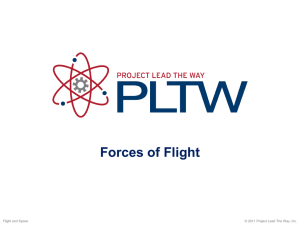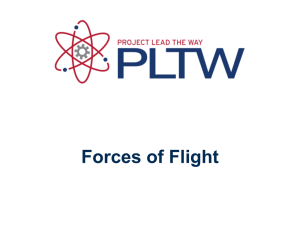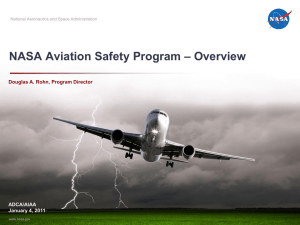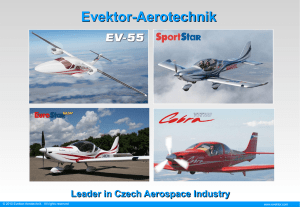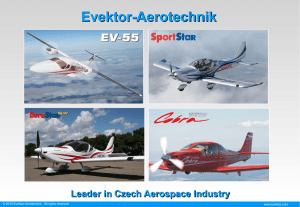Invention of the airplane
advertisement
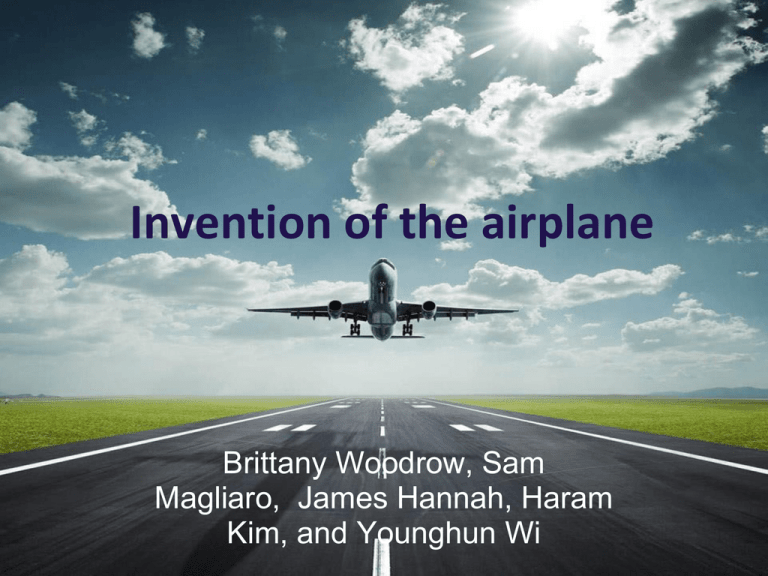
Invention of the airplane Brittany Woodrow, Sam Magliaro, James Hannah, Haram Kim, and Younghun Wi Prevailing View Before Discovery If birds can fly, why not people? • Originally, engineers thought that when a bird's wings flapped, that motion was what caused it to lift by forcing air downward. • Many early flying machines were based on the flapping motion, all of which failed. • The secret was discovered by Sir George Cayley and later by Otto Lilienthal in the 1890s. They found that the thrust and lift from a bird's flight are separate. • The flapping of a bird's wings is actually directing air mostly backwards. It is the SHAPE of the wing that causes lift by changing the air pressure above and below the wing as air rushes over it. This principle is what makes flight possible on modern airplanes. Description of Discovery • December 17, 1903: Kitty Hawk, North Carolina o the Wright Flyer became the first powered machine to sustain controlled flight with a pilot aboard. • Wilbur and Orville Wright o Between 1899 and 1905, the Wright brothers conducted a program of aeronautic research in which they experimented with and refined designs and models that eventually led to the creation of the first practical airplane. o All successful airplanes since then have incorporated the basic design elements of the 1903 Wright Flyer http://www.nasm.si.edu/wrightbrothers/fly/1900/index.cfm The physics of flight There are four basic forces when an airplane is at flight: 1. Lift 2. Thrust 3. Gravity 4. Drag Only gravity is constant. • If an airplane is flying at a constant speed, all the forces are in equilibrium. Lift: • The lift on the plane can be achieved through the crosssectional shape wings. • As the plane flies, the air over the top of the wing flows faster than the air under the bottom. So the top part of the wing generates the lower pressure and the bottom part creates the high pressure. This pressure difference generates the lift on the airplane in an upward direction. • The angle of the wings causes the plane to fly at different angles. The physics of flight (cont.) Thrust: • Propellers are the key to the plane's thrust. The air in front of the propeller is sucked in and is pushed back toward the tail. The force generated by this action is thrust. A more powerful propeller makes the plane go faster. The thrust is controlled by raising or lowering the rate per minute (rpm) of the engine by using the throttle. Drag: • When an airplane travels using the propeller, an undesired effect is created: resistance. When the aircraft travels through the air, its frontal area pushes against the air in front of it, and the air flowing over the aircraft causes friction. This is know as drag. So, a narrower and lighter aircraft goes faster because it reduces drag and resistance. How the Discovery Impacted Society • At the start of World War I, air powered aircraft had become practical for reconnaissance, artillery spotting, and even attacks against ground positions. • Aircraft began to transport people and cargo as designs grew larger and more reliable. Giant rigid airships became the first aircraft to transport passengers and cargo over great distances. • After WWII, especially in North America, there was a boom in general aviation, both private and commercial. Thousands of pilots were released from military service and many inexpensive warsurplus transport and training aircraft became available. • Aviation also has an environmental impact. Operating powered aircraft (from airliners to hot air balloons) releases pollutants and greenhouse gases such as carbon dioxide(CO2) into the atmosphere. How the Discovery Impacted Society (Cont.) • Civil aviation includes all non-military flying such as transport aircraft and general aircraft. Transport aircraft mainly transport hardware and personnel, and general aviation may include business flights, private aviation,flight training, ballooning, parachuting, gliding, hang gliding, launched powered hang gliders, air ambulance, crop dusting, traffic reporting, police air patrols and forest fire fighting. • Military aviation is the use of aircraft enabling warfare. This includes fighter aircraft, ground-attack aircraft, bombers, transport, surveillance and missiles. Fighter aircraft destroys other aircraft. Ground-attack aircraft can be used to provide support for ground troops. Bombers are normally larger, heavier, and less maneuverable than fighter aircraft. Transport aircraft are used to transport hardware and personnel. Surveillance aircraft obtain information about enemy forces. Missiles deliver warheads, normally explosives, but also things like leaflets. Works Cited “Air Transport.” Alena Veverka. pond.cz, 2012. Web. 21 Feb. 2012. <http://alena.veverka.eu/english/lessons.html?id=116>. Anderson, Kevin. “Reframing climate change: from long-term targets to emission pathways.” Tyndall’s Centre’s Energy Programme. University of Manchester. 17 June 2008. Tyndall Centre. Web. 22 Feb. 2012. <http://transitionculture.org/wp-content/uploads/kevin-anderson-2.ppt>. "A Brief History of Airplanes." Everyday Guide. Web. 24 Feb. 2012 <http://www.everydayguide.com/a-brief-history-of-airplanes/>. “Gulf Vision Aviation.” Virtual Aviation. Airblue, 2011. Web. 20 Feb. 2012. <http://gulfv.virtualave.net/>. "The Wright Brothers: The Invention of the Aerial Age." National Air and Space Museum. Smithsonian Institution, 2012. Web. 22 Feb. 2012. <http://www.nasm.si.edu/wrightbrothers/index_full.cfm>. "Vertebrate Flight." Basic Flight Physics. UCMP. Web. 22 Feb. 2012 <http://www.ucmp.berkeley.edu/vertebrates/flight/physics.html>. Fin.



